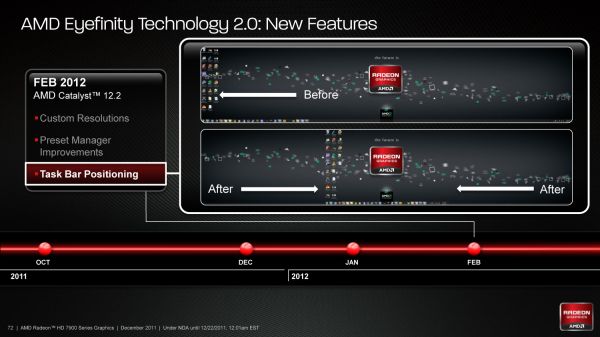AMD Radeon HD 7970 Review: 28nm And Graphics Core Next, Together As One
by Ryan Smith on December 22, 2011 12:00 AM EST- Posted in
- GPUs
- AMD
- Radeon
- ATI
- Radeon HD 7000
Display Tech: HD3D Eyefinity, MST Hubs, & DDM Audio
With the launch of the HD 5000 series back in 2009 AMD managed to get the drop on everyone, press and NVIDIA alike. Eyefinity, AMD’s Single Large Surface technology, came out of virtually nowhere thanks to a carefully orchestrated development plan that ensured very few people even within AMD knew about it. As a result of everything that was leaked ahead of time Eyefinity was not, making it AMD’s big eye catcher for the 5000 series.
As what was to be the first piece of the much dreamed about holodeck, AMD has been steadily working on it since 2009 in order to improve the experience even within their existing hardware by adding support for such features as bezel compensation and combining CrossFire with Eyefinity. For AMD it’s a feature of great importance even if end user adoption is still limited.
For the Southern Islands family AMD isn’t going to be pulling quite the rabbit out of their hat this time when it comes to displays. Southern Islands’ new display feature will be Discrete Digital Multi-Point Audio (which we’ll get to in a moment), but this doesn’t mean that AMD hasn’t continued to work on Eyefinity. Since October AMD has been engaged in an initiative they’re calling “Eyefinity Technology 2.0”, which is going to be pushed as a big part of the Southern Islands launch even though these are software improvements that will benefit all cards.
So what is Eyefinity Technology 2.0 composed of? We’ve already seen several new features starting with Catalyst 11.10, such as 5x1 portrait and landscape support and flexible bezel compensation support. The next step is going to be integrating Stereo 3D (or as AMD likes to call it, HD3D) into the mix, similar to how NVIDIA has 3D Vision Surround. Catalyst 11.12 introduced the ability to use HD3D with an Eyefinity display setup, and Catalyst 12.1 (preview out now) added support to do that in a CrossFire configuration. The final step is going to be with Catalyst 12.2 in February, which will add support for custom resolutions and the ability to relocate the Windows task bar to an arbitrary screen, two features that users have been asking about for quite some time. Again, all of these improvements are driver side, but they are a major component of AMD’s marketing for Southern Islands.
Speaking about Eyefinity, one issue that comes up time and time again is Multi Stream Transport (MST) hubs. We were introduced to MST hubs back with the launch of the 6800 series, which allowed a single DP 1.2 port to drive up to 4 monitors by taking advantage of the high bandwidth of DP1.2 and embedding transport streams for several monitors into the signal. The purpose of MST hubs was so that users could use several monitors with a regular Radeon card, rather than needing an exotic all-DisplayPort “Eyefinity edition” card as they need now.
But as many of you have asked me about, several deadlines for MST hubs have come and gone, including the latest deadline which was supposed to be by the end of this year. As with active DP adaptors this is largely out of AMD’s hands since they don’t produce the hardware, but they have been continuing to prod their partners on the issue. The latest deadline from AMD isn’t rosy – summer of 2012 – but they seem more confident of this deadline than deadlines in the past. Not that another half-year wait will be of any comfort for users who have been looking for MST hubs for the better part of the year, but at least it provides some idea on when to expect them.
Last, but certainly not least on the display technologies front is AMD’s new feature for Southern Islands, Discrete Digital Multi-Point Audio (DDMA). It’s a mouthful of a name but the concept is rather simple: it’s the next step in audio output from a video card. Video cards have been able to output audio for a few years now via HDMI, and more recently DisplayPort gained the ability. However GPUs have been limited to streaming audio to a single device, be it a monitor, TV, or receiver. With DDMA GPUs can send audio to multiple devices, and AMD is looking at how to put that ability to work.
The most basic use for being able to send audio to multiple devices is to individually address the speakers of each device, which is the cornerstone of AMD’s proposed use cases. Fundamentally AMD is looking at applications that involve matching audio streams to the monitor the relevant application is on – move a video player from your center monitor to your left monitor, and the audio from that video player should also move from the speakers on the middle monitor to the speakers on the left monitor. What can you do with speakers that are mapped to monitors? That’s what AMD wants to find out.
Being realistic for a moment, the 7970 isn’t going to be the card that sells this feature, as it’s a $550 gamer video card. Gamers are using dedicated 2.1/5.1/7.1 audio systems or headphones for surround sound, and while AMD does have a proposed multi-tasking use case for this it’s not very convincing. DDMA will become much more important on future lower end cards as those are the cards that go into family desktops, workstations, and the like. Thus the killer app for this feature (and certainly AMD’s best prepared scenario) is for video conferencing where each attendee is mapped to a monitor, and with DDMA a set of speakers on that monitor. AMD’s partner Oovoo is working on just such a system though it’s still early in development.












292 Comments
View All Comments
MadMan007 - Thursday, December 22, 2011 - link
More stuff missing on page 9:[AF filter test image] [download table]
Ryan Smith - Thursday, December 22, 2011 - link
Yep. Still working on it. Hold tightMadMan007 - Thursday, December 22, 2011 - link
Np, just not used to seeing incomplete articles publsihed on Anandtech that aren't clearly 'previews'...wasn't sure if you were aware of all the missing stuff.DoktorSleepless - Thursday, December 22, 2011 - link
Crysis won't be defeated until we're able to play at a full 60fps with 4x super sampling. It looks ugly without the foliage AA.Ryan Smith - Thursday, December 22, 2011 - link
I actually completely agree. That's even farther off than 1920 just with MSAA, but I'm looking forward to that day.chizow - Thursday, December 22, 2011 - link
Honestly Crysis may be defeated once Nvidia releases its driver-level FXAA injector option. Yes, FXAA can blur textures but it also does an amazing job at reducing jaggies on both geometry and transparencies at virtually no impact on performance.There's leaked driver versions (R295.xx) out that allow this option now, hopefully we get them officially soon as this will be a huge boon for games like Crysis or games that don't support traditional AA modes at all (GTA4).
Check out the results below:
http://www.hardocp.com/image.html?image=MTMyMjQ1Mz...
AnotherGuy - Thursday, December 22, 2011 - link
If nVidia released this card tomorrow they woulda priced it easily $600... The card succeeds in almost every aspect.... except maybe noise...chizow - Thursday, December 22, 2011 - link
Funny since both of Nvidia's previous flagship single-GPU cards, the GTX 480 and GTX 580, launched for $499 and were both the fastest single-GPU cards available at the time.I think Nvidia learned their lesson with the GTX 280, and similarly, I think AMD has learned their lesson as well with underpricing their HD 4870 and HD 5870. They've (finally) learned that in the brief period they hold the performance lead, they need to make the most of it, which is why we are seeing a $549 flagship card from them this time around.
8steve8 - Thursday, December 22, 2011 - link
waiting for amd's 28nm 7770.this card is overkill in power and money.
tipoo - Thursday, December 22, 2011 - link
Same, we're not going to tax these cards at the most common resolutions until new consoles are out, such is the blessing and curse of console ports.